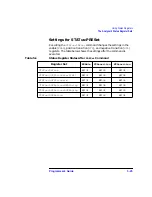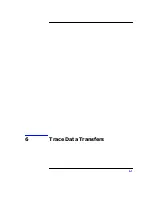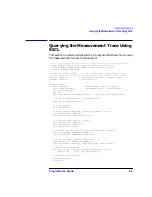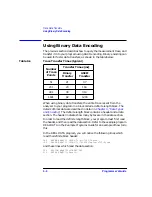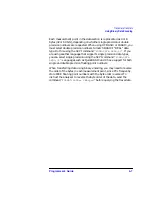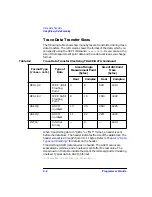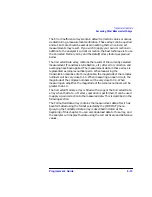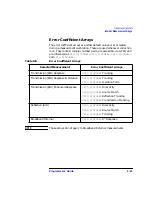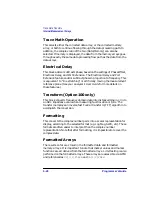
Programmer’s Guide
6-13
Trace Data Transfers
Querying Single Data Points Using Markers
Querying Single Data Points Using
Markers
If you only need to query a single data point, you can use a marker query
instead of a trace query. The program segment below shows how to do
this using the SCPI command
CALC:MARK
.
10
ASSIGN @Hp8711 TO 716
20
! Take sweep here
30
OUTPUT @Hp8711;"CALC1:MARK ON"
! turn on marker
40
OUTPUT @Hp8711;"CALC1:MARK1:X 177 MHz"
! set frequency
50
OUTPUT @Hp8711;"CALC1:MARK1:Y?"
! read marker
60
ENTER @Hp8711;Marker_y
70
DISP Marker_y
You can also use the
CALC:MARK:FUNC:RES?
query to return the results
of a bandwidth search. The following program steps accomplish these
tasks:
10
! Select -3 dB bandwidth
20
OUTPUT @Hp8711;"CALC:MARK:BWID -3"
30
! Get result of bandwidth search
40
OUTPUT @Hp8711;"CALC:MARK:FUNC:RES?"
50
ENTER @Hp8711;Bwidth,Center_freq,Q,Loss
For more information on using markers, refer to the Example Programs
Guide.
Summary of Contents for 8712ES
Page 11: ...1 1 1 Introduction to GPIB Programming ...
Page 27: ...2 1 2 Synchronizing the Analyzer and a Controller ...
Page 36: ...3 1 3 Passing Control ...
Page 39: ...4 1 4 Data Types and Encoding ...
Page 46: ...5 1 5 Using Status Registers ...
Page 71: ...6 1 6 Trace Data Transfers ...
Page 98: ...6 28 Programmer sGuide Trace Data Transfers Internal Measurement Arrays ...
Page 99: ...7 1 7 Using Graphics ...
Page 105: ...8 1 8 Front Panel Keycodes ...
Page 111: ...9 1 9 Introduction to SCPI ...
Page 129: ...10 1 10 Menu Map with SCPI Commands ...
Page 268: ...12 1 12 SCPI Conformance Information ...
Page 290: ...13 1 13 SCPI Error Messages ...

